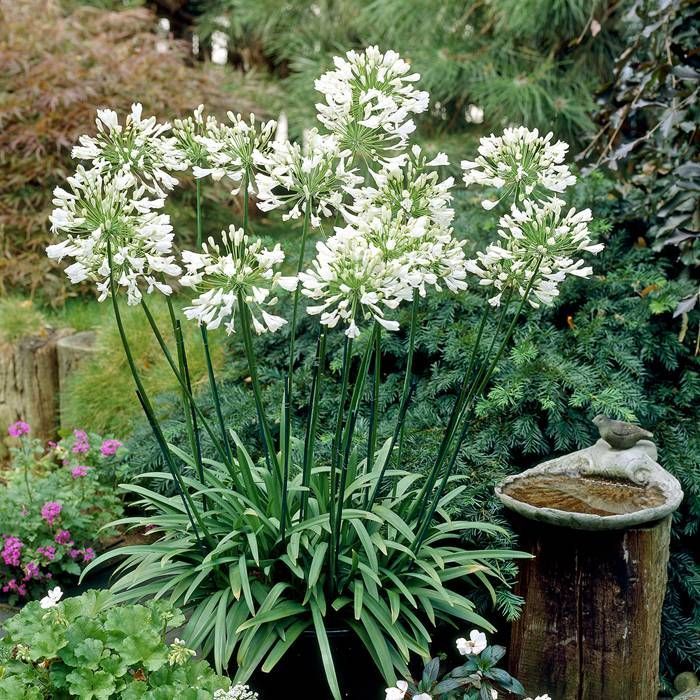Grasping the Art of Agapanthus Treatment: Vital Steps for Healthy Growth and Vivid Blossoms
In the realm of cultivation, the farming of agapanthus stands as a satisfying endeavor for those that seek to support these stylish blooming plants. From choosing the appropriate selection to grasping pruning methods, the trip towards growing prospering agapanthus plants is complex and holds the essential to unlocking the full potential of these agricultural gems.

Picking the Right Agapanthus Selection

When picking the right Agapanthus variety for your yard, take into consideration aspects such as climate viability, bloom shade, and growth behavior. Agapanthus, generally called Lily of the Nile or African lily, is available in a variety of shades varying from tones of blue and purple to white. Pick a flower shade that enhances your existing yard combination to create a harmonious landscape. In addition, think about the environment in your area to make certain the Agapanthus range you choose can grow in your specific problems. Some selections are extra tolerant of cool temperature levels, while others favor warmer climates. Recognizing the growth practice of various Agapanthus selections is important for appropriate positioning within your yard. Some varieties have a clumping development habit, perfect for containers or boundaries, while others have a more dispersing nature, ideal for ground cover or mass growings. By very carefully examining these factors, you can choose the perfect Agapanthus range to improve the beauty of your yard.
Perfect Planting Problems
Thinking about the optimal environmental needs is important for effective Agapanthus farming. Agapanthus flourishes in well-draining soil with a slightly acidic to neutral pH degree. When growing, choose a location that receives full sunshine to partial color. In hotter climates, providing some mid-day shade can protect against scorching of the fallen leaves. Agapanthus plants are sensitive to chilly temperatures and need to be shielded from frost throughout cold weather.
To ensure healthy and balanced growth and vibrant flowers, plant Agapanthus light bulbs at a depth of regarding 2-4 inches and room them 8-12 inches apart. Mulching around the base of the plants aids keep dampness and reduces weed growth.
Watering and Fertilizing Tips
Keeping proper dampness levels and supplying necessary nutrients are essential aspects in the care regimen for Agapanthus plants. When it comes to sprinkling Agapanthus, it is essential to strike a balance. These plants favor constantly wet dirt yet are at risk to root rot if overwatered.
Fertilizing Agapanthus is necessary for advertising healthy and balanced development and prolific flowers. Apply a balanced plant food, such as a 10-10-10 formula, in the early springtime as brand-new growth emerges. By following these watering and fertilizing suggestions, you can ensure your Agapanthus plants thrive and generate vivid, long-lasting blossoms.
Pruning Strategies for Agapanthus
Trimming Agapanthus plants at the appropriate times and with proper techniques is essential for keeping their health and advertising ideal growth and blooming. The excellent time to prune Agapanthus remains in late winter months or early springtime before new development arises. Begin by getting rid of any kind of dead or yellowing fallen leaves near the base of the plant. Cut them as close to the ground as feasible without damaging the emerging shoots.
Deadheading invested blossoms this article can additionally find more information redirect the plant's power right into creating more blooms rather than setting seeds. If you want to accumulate seeds for propagation, leave some blossoms to fully grown and completely dry on the plant.
Keep in mind to use tidy, sharp tools to make precise cuts and minimize the danger of presenting diseases. Agapanthus. Normal pruning will assist keep your Agapanthus looking neat and healthy while making sure a plentiful display screen of beautiful blooms
Dealing With Typical Insects and Illness
After making sure proper trimming strategies for Agapanthus, it is essential to address typical insects and conditions that can affect the wellness and vigor of these plants. Agapanthus plants are typically sturdy yet can still drop victim to certain problems. One usual parasite that influences Agapanthus is the Agapanthus gall midget. This small, orange fly lays its eggs in the vegetation, leading to distorted growth and flower buds that fail to open up. To fight this bug, trim and ruin any damaged plant parts and think about using insecticidal soap.
An additional typical problem is fungal leaf spot, which offers as dark lesions on the leaves. To avoid fungal illness, make certain great air flow around the plants, prevent overhead watering, and get rid of any kind of contaminated leaves quickly. Additionally, Agapanthus plants can struggle with root rot if they are planted in inadequately draining pipes soil. To avoid this, plant Agapanthus in well-draining dirt and prevent overwatering. By being alert and taking prompt activity against pests and conditions, you can assist your Agapanthus plants flourish and create dynamic blooms.

Final Thought
Finally, mastering the art of agapanthus treatment entails selecting the best selection, offering suitable planting conditions, proper watering and fertilizing, appropriate pruning strategies, and addressing common pests and illness. By complying with these necessary steps, you can guarantee healthy and balanced growth and vivid blossoms for your agapanthus plants. Bear in mind to routinely keep an eye on and maintain your plants to advertise their overall well-being and long life.
To make certain healthy and balanced development and dynamic blooms, plant Agapanthus bulbs at a depth of regarding 2-4 inches and space them 8-12 inches apart. By following these watering and fertilizing ideas, you can guarantee your Agapanthus plants grow and produce dynamic, lasting blooms.
One usual insect that affects Agapanthus is the Agapanthus gall midge. In addition, go to this website Agapanthus plants can experience from origin rot if they are grown in poorly draining dirt. By complying with these crucial actions, you can make sure healthy and balanced growth and vibrant blossoms for your agapanthus plants.